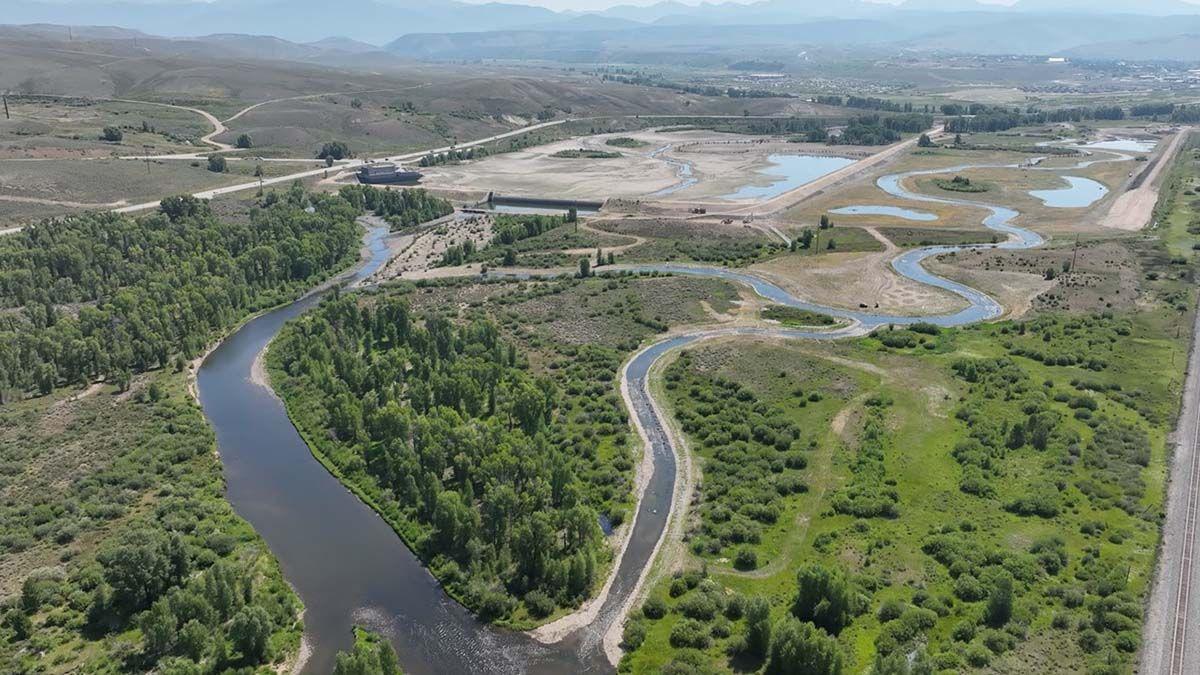
Colorado River Connectivity Channel
Discover how our work on the Colorado River Connectivity Channel (CRCC) is balancing water resource management with environmental conservation.
A highly collaborative undertaking, we have been providing engineering design, river restoration, and permitting services as part of a significant environmental project to uplift the Colorado River system upstream and downstream of the Windy Gap Reservoir.
At 1,450 miles long, the Colorado River is often referred to as the “lifeline of the Southwest,” with a drainage basin that includes parts of seven states in the U.S. and two in Mexico. The river and its tributaries are a vital source of water for more than 40 million people.
Built in the 1980s, the Windy Gap Reservoir provided much-needed water for municipal use, but it also created a barrier for fish migration and hindered the natural flow of the river, negatively impacting aquatic ecosystems through elevated stream temperatures and reducing sediment transport. The CRCC restores the river’s natural flow, allowing fish and other aquatic species to migrate freely and enhancing overall river health by improving stream temperatures and sediment transport.
Drawing upon nature’s own innovations to restore it
Cutting the Windy Gap Reservoir in half to construct a smaller reservoir and create a new floodplain enabled us to put a new river-like channel through the original reservoir, including an engineered, natural-looking riffle to divert water into the new reservoir. This bypass is allowing for fish passage and sediment transport up and down the channel — from the diversion point all the way down through the system and back to the Colorado River downstream of the reservoir.
By mimicking the river’s diverse landscape as part of our design, immediate positive outcomes of the new channel include:
- Connectivity for aquatic life, including fish passage for mottled sculpin and trout
- Enhanced aquatic habitat for fish and macroinvertebrates
- Improved bedload sediment transport around Windy Gap Reservoir
- Moderated potential elevated temperatures in the Colorado River downstream from Windy Gap Reservoir
Dividing the reservoir in half for the new channel has, in essence, given equal balance to both water resource development and environmental preservation, maintaining reliable and safe operation of Windy Gap Dam and Pump Plant while simultaneously maintaining the enhanced aquatic habitat.
The ripple effects of connecting stakeholders to reconnect a river
The Municipal Subdistrict contracted with AECOM to conduct the final design for the CRCC Project. Other major project and funding partners include Trout Unlimited, Natural Resources Conservation Service, Colorado Parks and Wildlife, Colorado Water Conservation Board, Grand County, the Colorado River District and the Upper Colorado River Alliance, with contributions ranging from design and project management to fundraising and time. Corporate funding partners include Pepsi, FritoLay, Intel and the Bonneville Environmental Fund. With such wide-ranging stakeholders invested in ensuring a successful connectivity channel, it’s no wonder the project results have been equally as wide-ranging.
Beginning with restoring the natural world — a key segment of the Upper Colorado River — the CRCC Project’s outcomes have only rippled outward to yield a multi-faceted set of benefits. Along with re-establishing river flow and renewed aquatic habitats, they include:
- More than 1 mile of new stream length
- A naturally adjustable river corridor
- Approximately 50 acres of new riparian floodplain
- Over 10 acres of new wetlands
- Restoration of 90 acres of land
- Entrance into the FEMA National Flood Insurance Program
Beyond the river reconfiguration near the Windy Gap Reservoir and restoration of its environs, our continued efforts — including the planting of 20,000 new trees and opening the new channel to fishing and tourism — will yield lasting environmental, social, and economic benefits.
Benefits that far outlast the project
The CRCC Project will restore the ecological balance and resilience to the Colorado River and the communities that depend on it. Here's how:
-
Restoring River Connectivity. Reconnecting the Upper Colorado River allows fish and aquatic species to migrate freely past the Windy Gap Reservoir for the first time in decades. This restoration of natural river flow supports biodiversity and strengthens the broader ecosystem.
-
Improving Water Quality and Habitat. Reintroducing flow and flushing out stagnant waters helps improve water quality and reduce sediment buildup, thus benefiting aquatic life and water users downstream.
-
Creating a Sustainable Water Management Model. The CRCC project balances water resource development with environmental stewardship, demonstrating how infrastructure can be re-engineered to protect ecosystems while still meeting human water needs.
-
Recreational and Economic Benefits: The revitalization of the river’s ecosystem will likely enhance local recreation, such as fishing and tourism, which can provide sustained economic benefits for the community.
-
Legacy of Collaboration: The CRCC exemplifies a successful collaboration between federal agencies, local governments, environmental organizations, and water stakeholders, serving as a cooperative model to inspire future water management and conservation projects in Colorado and beyond.
Watch a video about the project: Colorado River Connectivity Channel Final Season of Construction - Summer 2024